To prune or knot to prune.
Anyone who has ever driven through Alberta has probably seen Black Knot in all its dark glory. It may have been a double take at that sickly black Mayday or a flash of confusion at how someone got feces stuck so high in a Schubert. Black knot runs rampant in Alberta appearing as angry black clumps dangling over fences and causing disagreements between arborists and tree owners alike.
On one side of the argument is that Black Knot cannot be completely cured and that the unfortunate infected trees should be cut out of their misery. The other side preens that proper pruning can keep it reigned in so that trees can still thrive and grow beautifully, despite the fungus. Each side has its merits and in order for you to make a comfortable decision of how to handle your infected trees, keep reading below.
Black Knot or Apiosporina morbosa is a North American fungus that targets trees of the Prunus genus. While black knot can infect any tree of the Prunus genus it tends to infect the cherry and plum species most severely. Here in Alberta, cultivars of the native choke cherry and pin cherry trees like Schubert chokecherry and Mayday trees are planted commonly because of their hardiness and perfect size for urban setting. Fast growing with scented flowers in the spring and rich foliage in the summer they can be found across Alberta filling the street sides with rich purple leaves or buzzing with bee filled blooms.
Now, more about our villain Mr. Knot. Let us help you understand what we’re dealing with.
Black Knot fungus is identified in its mature form as dark crusty galls on the ends of tree branches. It can also be found in more sever infections in branch crotches and even on the main stem of a tree. By the time we see it in this stage it has already set out to spread!
The spores lay dormant in mature galls during the winter and are released in the spring with the early rains. Wind will carry the spores to neighboring trees where they will settle into open wounds or more commonly on new green shoots. A brief combination of moist conditions and warm weather allows the spores to germinate and infect the healthy tree cells they are in contact with. For several months the infection will show no symptoms while it secretes acids and growth control chemicals that will start to swell the area. This is when the knot first becomes visible but is very easy to miss, even more so when the tree is covered in leaves.
Over the next year the knot swells and matures into the ashy cork like chunks that are more obvious and hideous. The disease cycle tends to run between 1 to 2 years but varies depending on environmental conditions.
Many infected trees can live long after becoming infected, but their natural growth patterns can be severely disrupted by the fungus if left unchecked. In the summer, the Black Knot can often be hidden in thick foliage and expose it grimace again in the fall.
Black Knot kills trees in two ways.
– the Knot infection can encircle entire branches or crotches, preventing everything above it from receiving essential nutrients and water, causing enough die back that the tree no longer has enough foliage to sustain itself.
– Severe black knot infections can infect major stems; over time these infections will compromise the stems structural integrity and major breakage can occur.
If black knot doesn’t kill the tree itself, it opens the door for other parasites and fungus to send the tree into a state of decline. Mature knot galls will eventually crack open or split. Exposing a convenient entry into the trees inner workings.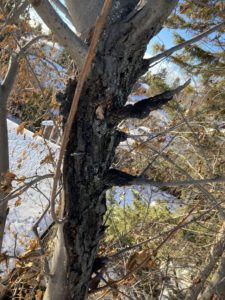
Now that you understand the issues you can make your own judgment of how to handle your infected trees.
If you’re going to reign in the knot these are things you will want to do.
- Do not prune in wet conditions, doing so will help the fungus spread. It is best to prune in the late fall and winter when the fungus is dormant. Be sure not to leave any clipping and dispose of them correctly. Make sure your tools are regularly treated to stop the fungus spread.
- Prune out all visible black knot galls. Cut each infection back at least 8-inches from the gall and to the nearest lateral. Cutting the galls off too close to the infection site may leave parts intact in the branch. Always make proper cuts to help the tree heal the wounds. A wound that does not heal will easily become infected again and become an entry for other insects and disease.
- Improve the trees future health and resistance to ailments by removing damaged branches and crossing branches likely to be damaged. Deadwood should also come out, when deciding how much canopy your tree can lose do not consider the deadwood as canopy.
- After pruning out the black knot and damaged branches you can decide if the tree has enough canopy left to sustain itself. As a rule of thumb never remove more than 25-30% of the trees canopy in 1 year. If the tree still has enough canopy you can thin it for improved airflow within the trees canopy. All fungi thrive in damp cool conditions, more air flow will help the tree stay strong!
- If a tree has been pruned aggressively and lost a large portion of canopy then give it as much time it needs to recover what its lost. With heavy infections expect the tree to look very strange for the first couple years while the canopy regrows. After the initial pruning trim out the new galls as needed until the tree recovers.
While we love trees, sometimes it’s wiser to remove the tree all together. If the main stems and branches are infected or removing all the galls will leave the tree without the canopy it needs to survive then you may want to cut it down. It is also acceptable to leave a little bit of the black knot in the tree to be removed the following year.
If a tree is severely infected and needs to be removed then be sure to have the stump ground out as well because choke cherry is an extremely persistent species that will try to regrow from just a stump. However it is likely regrowth will also have Black Knot and will never develop strong structure.
Always dispose of black knot fungus by burning, burying, or removing it from the site. The spores will still spread even after cut from the tree.
References
https://www.alberta.ca/black-knot.aspx
Diseases Of Trees And Shrubs (2nd Edition) Authors : Wayne A.Sinclair & Howard H.Lyon
Referenced Professional
Denise Allen, ISA Certified Master Arborist, December 2020

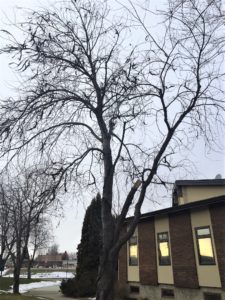
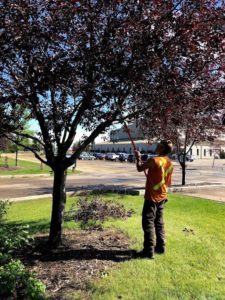
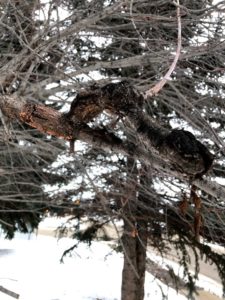

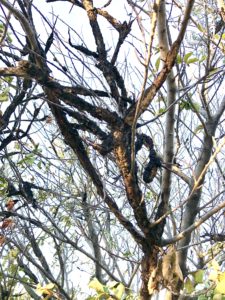
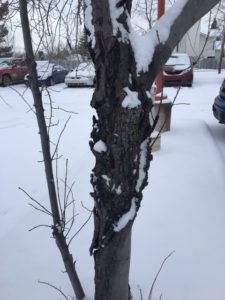
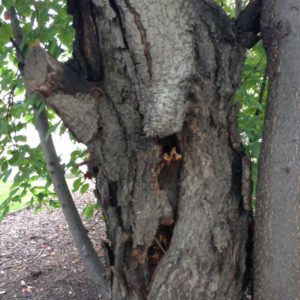
Comments are closed